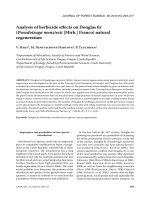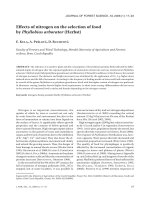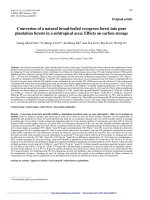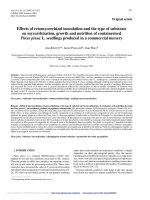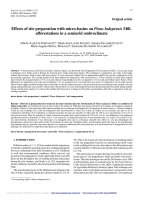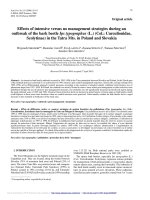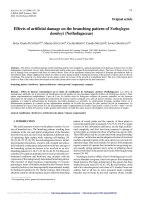Báo cáo lâm nghiệp: " Effects of ectomycorrhizal inoculation and the type of substrate on mycorrhization, growth and nutrition of containerised Pinus pinea L. seedlings produced in a commercial nursery" docx
Bạn đang xem bản rút gọn của tài liệu. Xem và tải ngay bản đầy đủ của tài liệu tại đây (314.65 KB, 6 trang )
817
Ann. For. Sci. 62 (2005) 817–822
© INRA, EDP Sciences, 2005
DOI: 10.1051/forest:2005087
Original article
Effects of ectomycorrhizal inoculation and the type of substrate
on mycorrhization, growth and nutrition of containerised
Pinus pinea L. seedlings produced in a commercial nursery
Ana RINCÓN
a
*, Javier PARLADÉ
b
, Joan PERA
b
a
Departamento de Fisiología y Bioquímica Vegetal, Centro de Ciencias Medioambientales (CCMA-CSIC), C/ Serrano, 115 dupl., 28006 Madrid, Spain
b
Departament de Protecció Vegetal, Institut de Recerca i Tecnologia Agroalimentaries (IRTA), Centre de Cabrils, Ctra. de Cabrils s/n,
08348 Cabrils (Barcelona), Spain
(Received 3 January 2005; accepted 22 August 2005)
Abstract – Spore inocula of Melanogaster ambiguus (Vittad.) Tul. & C. Tul., Pisolithus tinctorius (Pers.) Coker & Couch, Rhizopogon luteolus
Fr., Rhizopogon roseolus (Corda) Th. M. Fr. and Scleroderma verrucosum (Bull.) Pers., and two substrates (a mixture of peat-vermiculite and
a mixture of peat-composted pine bark) were evaluated for producing mycorrhizal Pinus pinea L. seedlings in a commercial nursery in NE
Spain. Inocula of all fungi were effective to obtain containerised mycorrhizal P. pinea seedlings although seedling mycorrhization rates were
reduced in the peat/pine-bark mixture. Neither inoculation nor the type of substrate modified the first-year growth of seedlings. Rhizopogon
spp. increased the levels of N and P and, in general inoculation reduced the concentration of Mn in needles. Symptoms of chlorosis were
detected in all seedlings growing in the peat/pine-bark mixture, probably due to nutritional deficiencies caused by the substrate high pH. Among
the fungi tested, R. roseolus is proposed as the best candidate for its application in nursery inoculation programmes destined to produced
containerised mycorrhizal P. pinea.
Pinus pinea / substrate / mycorrhization / ectomycorrhizal fungi / seedling nursery production
Résumé – Effets d’une inoculation ectomycorhizienne et du type de substrat sur la mycorhization, la croissance et la nutrition de semis
de Pinus pinea L. en containers produits en pépinière commerciale. Des inoculums sporaux de Melanogaster ambiguus (Vittad.) Tul. & C.
Tul., Pisolithus tinctorius (Pers.) Coker & Couch, Rhizopogon luteolus Fr., Rhizopogon roseolus (Corda) Th. M. Fr. et Scleroderma verrucosum
(Bull.) Pers., et deux substrats (un mélange de tourbe-vermiculite et un mélange de tourbe-écorce compostée de pin) ont été évalués pour
produire des jeunes plants mycorhizés de Pinus pinea L. dans une pépinière commerciale au Nord-Est de l’Espagne. Les inoculums de tous les
champignons ont été efficaces pour obtenir des semis mycorhizés de pin pignon en conteneur, bien que les taux de mycorhization ont diminué
dans le substrat vermiculite-écorce de pin. Ni l’inoculation ni le type de substrat n’ont modifié la croissance en première année des jeunes plants.
Les espèces de Rhizopogon ont augmenté les niveaux d’azote et de phosphore dans les aiguilles des plants et, en général, l’inoculation a réduit
la teneur en manganèse de ces feuilles. Des symptômes de chlorose ont été détectés dans tous les plants croissant dans le substrat vermiculite-
écorce de pin, probablement en raison des carences nutritionnelles provoquées par le pH élevé du substrat. Parmi les champignons étudiés, on
propose R. roseolus comme le meilleur candidat pour son application dans des programmes d’inoculation en pépinière destinés à produire des
plants de pin pignon mycorhizés en conteneur.
Pinus pinea / substrat / mycorhization / champignons ectomycorhiziens / production des semis en pépinière
1. INTRODUCTION
Pinus pinea is a common Mediterranean conifer well-
adapted to hot and dry conditions associated to this climate.
This pine produces edible nuts and plays an important ecolog-
ical role in arid zones by preventing erosion [25]. These char-
acteristics have increased the value of P. pinea in reforestation
and afforestation programmes in arid and semiarid regions [25,
26, 29]. Survival and initial growth of out-planted seedlings
under these unfavourable environmental conditions is highly
dependent on their physiological quality after the nursery
breeding period. Different biometrics (height, root collar diam-
eter, shoot-root ratio) and physiological parameters (photosyn-
thetic rates and nutrient accumulation in seedling tissues) have
been used as indexes to determine the quality of seedlings pro-
duced in nursery [14, 21].
Ectomycorrhizal symbiosis with fungi is the rule among
most forest tree species in natural conditions [34]. Inoculation
* Corresponding author:
Article published by EDP Sciences and available at or />818 A. Rincón et al.
with selected ectomycorrhizal fungi has been often signalled
as a promising cultural practise for improving the quality of
nursery seedling stock [4, 10, 24]. Mycorrhization can improve
not only the growth of the seedling but also their physiological
status by enhancing the photosynthetic capacity [11] and by
increasing the uptake of water and nutrients, and their accumu-
lation in the seedling tissues [3, 8].
Environmental conditions marked by the Mediterranean cli-
mate are characterised by prolonged dry periods with high tem-
peratures and concentrated rain in a few months. These climatic
conditions limit the activity of natural fungal inoculum of soils
by reducing the optimal time for fungal spores germination and
mycelial growth, thus minimising the opportunities for root
colonisation by native fungi [1, 26, 27]. Under these circum-
stances, controlled nursery inoculation of trees with suitable
ectomycorrhizal fungi can be an important advantage for suc-
cessful establishment of out-planted seedlings in Mediterra-
nean habitats.
Controlled mycorrhization of containerized seedlings is
highly dependent on the cultural practices applied in nursery
[9]. Generally, factors which affect the growth of seedling roots
also affect the development of ectomycorrhizas [24]. Main fac-
tors affecting seedling mycorrhization in nursery are the ferti-
lisation and irrigation regimes and the characteristics of the
potting substrate [4, 10]. Aeration, pH and cation-exchange
capacity are important aspects to be considered prior to the elec-
tion of substrates for seedling production [18]. Composting of
residual materials such pine bark is a common recycling prac-
tise for obtaining low-cost substrates suitable to produce orna-
mental and forest seedlings in nurseries [17, 33]. Nevertheless,
the effects of this type of substrates on the mycorrhizal status
of forest seedlings produced in nursery are poorly documented.
The objective of this work was to evaluate the effects of inoc-
ulation with spores of several ectomycorrhizal fungi using two
different substrates (sphagnum peat plus either vermiculite or
composted pine bark) on the mycorrhizal status, growth and
concentration of nutrients in needles of containerised P. pinea
seedlings produced in a commercial nursery.
2. MATERIALS AND METHODS
2.1. Plant material
Pinus pinea L. seeds were collected from natural forests in the
Montnegre and Montseny sierras in Catalonia (Spain). Before use,
seeds were soaked in running tap water overnight, surface disinfected
by shaking for 30 min in 33% (v/v) H
2
O
2
and rinsed in four changes
of sterile distilled water.
2.2. Fungal inoculum
Basidiomata of Pisolithus tinctorius (Pers.) Coker & Couch., Rhiz-
opogon luteolus Fr., Rhizopogon roseolus (Corda) Th. M. Fr., and
Scleroderma verrucosum (Bull.) Pers. were collected in bare-root
nurseries and mixed forests of P. pinea in different locations of Cata-
lonia (Spain). Sporocarps of Melanogaster ambiguus (Vittad.) Tul &
C. Tul, were collected under Pseudotsuga menziesii (Mirb) Franco
plantations in Girona (Spain). After collection, all basidiomata were
dried at 35 ºC for 72 h and kept at room temperature for further use
(voucher samples were kept at the herbarium of the DPV-IRTA).
To obtain the inoculum of M. ambiguus, R. luteolus and R. roseolus,
dry mature sporocarps of each fungal species were re-hydrated over-
night in distilled water and then blended at low speed until the spores
were suspended [5]. For each fungus, initial spore concentration was
assessed by using a haematocytometer. The bulk spores suspension
was diluted in water to obtain target suspensions of 10
6
spores mL
–1
for M. ambiguus, and 2 × 10
7
spores mL
–1
for both Rhizopogon species.
Due to their hydrophobicity, basidiospores of P. tinctorius and S.
verrucosum could not be prepared as water suspensions. Spores of
these fungi were removed from the sporocarps by sieving through a
0.5 mm mesh and counted with a haematocytometer (0.05 g spores in
100 mL H
2
O + two drops of Tween 20). One gram of P. tinctorius
and S. verrucosum spores contained 16 × 10
8
and 5 × 10
8
spores
respectively.
2.3. Nursery inoculations and experimental set-up
Pinus pinea L. seedlings were produced in the commercial nursery
owned by Forestal Catalana S.L. in Breda (Girona, Northeastern
Spain). A factorial experiment was set up in order to check the effect
of the factors: (a) inoculation with spores of the five ectomycorrhizal
fungi and (b) type of substrate, on mycorrhization and development
of P. pinea seedlings. Seedlings were grown in two different substrates
commonly used in the nursery: (1) a mixture of peat and vermiculite
(p/v) 1:1 (v:v) and (2) a mixture of peat and composted pine bark
(p/pb) 1:1 (v:v) (see Tab. I for substrate analyses). The peat Floratorf
was purchased at Floragard (Oldenburg, Germany) and the vermicu-
lite Termita
®
, grade 2 at Asflatex S.A. (Barcelona, Spain). Trays with
39 alveoles of 400 cm
3
each (Forespot, La Fageda-Spain) were filled
with the different substrates, and two P. pinea seeds were sowed per
alveole. Once germinated, seedlings were thinned to one per container.
Inoculation treatments were performed with spores of the five fun-
gal species plus non-inoculated control plants.
One-month-old seedlings were inoculated with 10 mL of the target
spore suspension of the corresponding fungus. The final inoculum
concentration was of 10
6
spores per seedling for M. ambiguus and
10
7
spores per seedling for R. luteolus and R. roseolus treatments. Dry
spores of P. tinctorius or S. verrucosum were added to a known volume
of autoclaved vermiculite before their application. Inoculation with
these fungi was carried out by mixing the vermiculite containing the
spores with the potting substrate to reach a final concentration of 10
7
spores per seedling in both cases. For all fungi tested, the choice of
the spore concentration was based on previous results [32].
Seedlings were fertilised every two weeks with a solution of 20-7-
19 Peters Professional Conifer Grower (Scott, Tarragona, Spain)
Tabl e I. Analytical characteristics of substrates used to grow Pinus
pinea seedlings in the nursery of Breda (Girona, North-Eastern Spain).
Substrate parameter Peat/Vermiculite
(p/v)
Peat/Composted
pine bark (p/pb)
pH (H
2
O 1:2.5) 5.5 7.7
E. C. (mS/cm) 2.6 2.1
Organic matter (%) 44 60
Total N (%) 0.4 0.7
Total P (%) 0.3 0.3
Total K (%) 2.3 0.6
Total Mg (%) 6.1 0.5
Total Fe (%) 2.4 0.8
Total Mn (ppm) 185 208
Nursery production of containerised P. pinea 819
(1.8 g L
–1
) and the micronutrients preparation Fetrilon (0.12 g L
–1
)
and Hortrilon (0.28 g L
–1
) (Basf, Barcelona, Spain) applied by the
nursery irrigation system. The amount of nutrients per plant applied
at each fertilisation was: 3.6 mg N (2.1 nitrate, 1.26 mg ammonia,
0.24 mg urea), 1.26 mg P, 3.42 mg K, 0.35 mg Fe, 0.07 mg Mg,
0.06 mg Mn, 0.06 mg Cu, 0.01 mg Zn, 0.01 mg B and 0.01 mg Mo.
2.4. Measured parameters
Ten months after inoculation, 25 seedlings were randomly har-
vested in each treatment. Seedling roots were washed free of substrate
and ectomycorrhizas were identified according to morphological cri-
teria derived from previous results obtained in synthesis and inoculum
dosage trials [31, 32]. Each seedling root was cut into 2–3 cm seg-
ments, and the percentage of ectomycorrhizal short roots was assessed
by counting at least 200 randomly selected short roots under the stereo-
microscope.
All seedlings were measured for stem height and root collar diam-
eter. Seedling shoots and roots were oven-dried (60 ºC, 48 h) to obtain
dry weights. Once dehydrated, needles of five plants of the same treat-
ment were grouped as a replicate and ground to a particle size < 2 mm.
After digestion of needles by nitric-perchloric acid (5:3), percentages
of N and P were determined by Kjeldahl and Olsen methods respec-
tively [37]. Concentrations of K, Mg, Mn and Fe were measured by
induced plasma spectrophotometry (F586-587, Varian Liberty 220).
2.5. Statistical analysis
Data were analysed by two-factor ANOVA and significant differ-
ences among treatments were detected by Tukey’s test (P < 0.05).
When factors interacted, they were separately analysed by one-way
ANOVA. Percentages of ectomycorrhizas were arc-sin transformed
before performing ANOVA.
3. RESULTS
3.1. Mycorrhization
When grown in p/v, all seedlings inoculated with P. tincto-
rius, R. luteolus, R. roseolus and S. verrucosum, and 53% of
those inoculated with M. ambiguus became mycorrhizal. When
p/pb was used, 100% of seedlings became mycorrhizal with
R. roseolus whereas this percentage was reduced to 53% and
33% in R. luteolus and S. verrucosum treatments, respectively.
In p/pb, spores inocula of M. ambiguus and P. tinctorius were
not effective and no mycorrhizal seedlings were obtained.
Among seedlings growing in p/v substrate, the percentages of
ectomycorrhizal short roots were of 19% for M. ambiguus, 45%
for P. tinctorius, 57% for S. verrucosum and more than 80%
for both Rhizopogon spp. (Fig. 1). Except for S. verrucosum,
the percentage of ectomycorrhizas obtained for all the fungi
tested was significantly reduced when seedlings grew in p/pb
compared with p/v substrate (Fig. 1).
3.2. Seedling growth
The effects of inoculation on seedling growth were analysed
only for R. luteolus, R. roseolus and S. verrucosum. The factor
inoculation showed a significant effect on almost all seedling
growth parameters, whereas the type of substrate did not sig-
nificantly influence the growth of seedlings (Tab. II). Inocula-
tion with either fungus generally did not stimulate and even
significantly decreased the seedlings growth (Tab. III).
3.3. Concentration of nutrients in needles
When the concentration of nutrients in needles was ana-
lysed, interaction between inoculation and type of substrate
was observed, and statistics were carried out separately for each
factor by one-way ANOVA.
In general, inoculation with the different fungi significantly
increased the concentration of N and P in needles in both sub-
strates, except for plants inoculated with S. verrucosum in p/v
(Fig. 2a). The level of N in plants inoculated with R. roseolus
and S. verrucosum was significantly higher when grown in p/pb
substrate compared with p/v, whereas the concentration of P in
needles was significantly higher when seedling grew in p/pb in
all inoculation treatments (Figs. 2a and 2b).
Tabl e II. ANOVA significance levels for the factors inoculation (A) and type of substrate (B), and interaction between them (AB) for different
growth parameters of Pinus pinea seedlings. Significant values (P < 0.05) are marked in bold.
Growth parameter Inoculation (A) Substrate (B) Interaction (AB)
Diameter 0.001 0.299 0.025
Height 0.338 0.998 0.571
Shoot dry weight (Sdw) 0.038 0.292 0.409
Root dry weight (Rdw) 0.000 0.234 0.862
Sdw/Rdw 0.000 0.777 0.154
Figure 1. Percentages of ectomycorrhizal short roots obtained by ino-
culation of Pinus pinea with five ectomycorrhizal fungi, growing in
two different substrates. p/v = peat / vermiculite (1:1, v:v); p/pb = peat/
pine bark (1:1, v:v). In each fungal treatment, different letters denote
significant differences between substrates according to Tukey’s test
(P < 0.05).
820 A. Rincón et al.
In general, inoculation with the different fungi in the p/v sub-
strate did not significantly affect the concentration of K, Mg
and Fe in needles (Figs. 2c, 2d and 2e). When seedlings grew
in p/pb substrate, R. luteolus significantly reduced the concen-
tration of K in needles, the level of Mg in needles was signifi-
cantly higher in R. roseolus and S. verrucosum treatments, and
the concentration of Fe was unaffected (Figs. 2c, 2d and 2e).
When substrates were compared, the concentration of K in nee-
dles of seedlings was significantly higher in seedlings grown
in p/pb (except for R. luteolus) (Fig. 2b), whereas the concen-
tration of Mg was significantly reduced (Fig. 2d). Seedlings
inoculated with both Rhizopogon spp. showed lower concen-
tration of Fe in needles when grown in p/pb compared with p/v
substrate (Fig. 2e).
In p/v, inoculation with the different fungi significantly
reduced the concentration of Mn in needles (Fig. 2f). In p/pb,
seedlings inoculated with R. roseolus showed the highest levels
of Mn in their needles (Fig. 2f). For all inoculation treatments,
the levels of Mn in needles were significantly lower in seedlings
grown in p/pb than in p/v (Fig. 2f).
4. DISCUSSION
Spore inoculum of all the fungi tested was effective to obtain
mycorrhizal P. pinea seedlings produced in container. The high
quantity of spores that can be obtained from one basidioma and
the ease of application of this type of inoculum makes of it a
method particularly well suited for large-scale inoculation of
containerised seedlings in commercial nurseries [4, 24]. Low
mycorrhization rates were obtained with M. ambiguus, with
only half of seedlings being mycorrhizal and percentages of
ectomycorrhizas (ECM) under 20%. The quantity of spores
applied was probably not high enough, since ECM percentages
over 80% have been previously obtained with this fungus for
P. pinea with application of spore rates over 10
7
spores per
seedling [32]. In the case of P. tinctorius, even if all plants
became mycorrhizal, the percentages of ECM did not reach
50%, the minimal limit established for this fungus to ensure an
effect on plant development after transplanting [23, 24]. The
minimal level of ECM necessary to ensure seedling perform-
ance in the field has been poorly studied, and probably depends
on environmental characteristics of the site of transplantation
and on the fungus-tree combination used [4, 34]. The spore
inoculum of P. tinctorius has been successfully used in previ-
ous experiments to produce containerised Pinus species,
including P. pinea [15, 28, 32].
The highest mycorrhization rates of P. pinea seedlings were
obtained with spores of R. luteolus and R. roseolus. Species of
the genus Rhizopogon have been previously used in nursery
Table III. Growth effect of inoculation with R. luteolus, R. roseolus and S. verrucosum on Pinus pinea seedlings. Different letters in each
column denote significant differences among treatments according to Tukey’ test (P < 0.05). Due to interactions, diameter was analysed sepa-
rately for each factor by one-way ANOVA. Asterisks denote significant differences in diameter between p/v and p/pb substrates according to
Tukey’ test (P < 0.05).
Diameter (mm) Height (cm) Shoot dry weight (g) Root dry weight (g) Sdw/ Rdw
p/v p/pb
Control 3.2 b 3.4 b 10.6 a 1.3 b 1.0 b 1.4 a
R. luteolus 2.6 a 3.1 ab* 10.2 a 1 a 0.6 a 1.7 b
R. roseolus 2.9 ab 2.9 a 10.6 a 1 a 0.6 a 1.7 b
S. verrucosum 3.3 b 3.0 ab 9.6 a 1 a 0.8 ab 1.4 a
Figure 2. Effect of inoculation and the type of substrate on the con-
centration of nutrients in needles of containerised P. pinea seedlings.
p/v = peat/vermiculite (1:1, v:v); p/pb = peat/pine bark (1:1, v:v). For
each type of substrate, different letters denote significant differences
between inoculation treatments according to Tukey’s test (P < 0.05).
For each inoculation treatment, asterisks denote significant differences
between p/v and p/pb substrates according to Tukey’s test (P < 0.05).
Nursery production of containerised P. pinea 821
programmes for the production of mycorrhizal P. pinea seed-
lings with similar results [27, 29, 32].
Both, the percentages of mycorrhizal seedlings and the col-
onisation level obtained with all the fungi tested in this study,
except with S. verrucosum, were significantly reduced when
seedlings were grown in the substrate containing peat and com-
posted pine bark (p/pb). For M. ambiguus and P. tinctorius,
composted pine-bark even totally prevented the formation of
mycorrhizas. The relatively high pH value (7.7) of the substrate
could have reduced the efficacy of all fungi tested. Since most
of them are acidophilous, both the germination of fungal spores
and the development of mycorrhizas can be severely affected
by pH values over 6 [9, 19]. Interestingly in p/pb substrate,
R. roseolus was the only fungus which colonised all seedlings,
forming ECM in percentages close to 70%. These results indi-
cate that inoculation with R. roseolus spores and the use of alter-
native less-expensive and recycled substrates are compatible
nursery practises for the production of mycorrhizal P. pinea
seedlings in container.
Inoculation with the different fungi generally did not stim-
ulate and even reduced seedlings growth. Low growth rates in
mycorrhizal plants have been often attributed to the high
demand for carbohydrates required by the fungus [11, 35]. The
lack of stimulation of seedlings growth by the fungi could also
be influenced by nursery practices like the fertilisation levels,
the type of substrate, or the container size [9]. When growing
in the soil, R. luteolus, R. roseolus and S. verrucosum produce
abundant external mycelium and rhizomorphs, which are of
great importance for water and nutrient uptake under field con-
ditions [7, 34]. However, the benefices of these fungal struc-
tures could be minimised under nursery conditions.
On the other hand, the type of potting substrate did not affect
P. pinea seedlings growth. Composted pine-bark is a substrate
commonly used in Spanish nurseries, and it has been previously
tested for the production of containerised P. pinea seedlings
with growth standards acceptable for its commercialisation [17].
Mycorrhization with the different fungi tested in this study
directly affected the nutritional status of P. pinea seedlings, and
therefore their physiological quality. Inoculation of P. pinea
with R. luteolus and R. roseolus increased the concentration of
N and P in needles. Some authors have demonstrated an
improved N and P uptake by mycorrhizal roots compared with
non-mycorrhizal ones [3, 13], although controversial results
have also been reported [11]. Inoculation with S. verrucosum
reduced the concentration of N, P, Mg and Mn in needles when
seedlings were grown in peat-vermiculite substrate, whereas
this effect was reversed in peat-pine bark substrate. These
results support the importance of the characteristics of the pot-
ting substrate affecting the availability of nutrients for the fun-
gus and its positive or negative effect on seedlings nutrition.
Also, other seedling parts such stem and roots as well as the
mantle and the external mycelium produced by the fungus may
act as nutrient storage structures and should be taken into
account in a global nutrient balance [7].
A common feature found for all fungi studied was that inoc-
ulation significantly reduced the levels of Mn in P. pinea nee-
dles from plants growing in the p/v substrate. Different authors
[2, 20] have demonstrated a lower Mn uptake in plants mycor-
rhizal with arbuscular fungi compared with non-mycorrhizal
ones. The availability of Mn for the plants is dependent on oxi-
dation/reduction processes often driven by soil microorgan-
isms capable to reduce Mn [22]. Some authors have suggested
that mycorrhization can inhibit the proliferation of such micro-
organisms in the rhizosphere by modifying the composition of
root exudates [16, 30].
Symptoms of chlorosis were detected in all seedlings grow-
ing in p/pb substrate, probably due to deficiencies in Fe, Mg or
Mn [21]. High pH values in the p/pb substrate could affect the
availability of nutrients to the plant and their accumulation in
needles [21, 22, 36]. At high pH levels, metallic micro-nutrients
such Fe, Mn, Cu and Zn are converted to insoluble oxides and
hydroxides not available for the plants [36]. For this reason,
many conifers tend to show chlorosis symptoms when grown
in alkali soils, and different authors recommend a pH of 5–6
for their production [36]. The quality of a substrate for conifer
production is directly related with its water retention capacity
and the porosity [18], and usually a mixture of equal parts of
sphagnum peat and vermiculite is recommended as potting sub-
strate for the production of mycorrhizal seedlings [4]. The ver-
miculite ameliorates the aeration properties of the substrate and
it has certain cation-exchange capacity which means higher
availability of nutrients like Mg and K for the plant [18]. In the
peat/composted pine bark substrate, the mixture of two organic
components gives a high C:N relation and this could be the
cause for the immobilisation of certain nutrients [4]. Ideally,
composted pine bark should be mixed with an inert substrate
such vermiculite, sand or perlite for a better aeration, fixing pH
levels not higher than 6 for the production of conifer seedlings.
Nevertheless, Mediterranean pines like P. pinea and P. halepensis
can properly grow in soils with neutral and even basic pH [29].
Among all fungi tested in this study, R. roseolus has dem-
onstrated the highest infectivity of P. pinea seedlings even in
a substrate with high pH levels. Several species of the genus
Rhizopogon have been successfully used for controlled myc-
orrhization of different conifers in nursery [5, 6, 12]. Moreover,
the efficacy of R. roseolus in field trials for P. pinea establish-
ment has been demonstrated [29]. Rhizopogon roseolus can be
considered as a good candidate for its application in nursery
inoculation programmes destined to produce containerised
mycorrhizal P. pinea seedlings.
Acknowledgements: This work was supported by the European Com-
mission Contract AIR2-CT94-1149. The first author was granted (94/
97 FPI programme) by the Ministerio de Educación y Ciencia, Spain.
REFERENCES
[1] Argillier C., Falconnet G., Tillard P., Mousain D., Essais d’intro-
duction dans un arénosol calcaire de Petite-Camargue de pins
pignons (Pinus pinea L.) mycorhizés par Suillus collinitus, Rev.
For. Fr. XLIX (1997) 131–140.
[2] Arines J., Porto M.E., Vilariño A., Effect of manganese on vesicu-
lar-arbuscular mycorrhizal development in red clover plants and on
soil Mn-oxidizing bacteria, Mycorrhiza 1 (1992) 127–131.
[3] Boxman A.W., Roelofs J.G.M., Some effects of nitrate versus
ammonium nutrition on the fluxes of Pinus sylvestris seedlings.
Effects of mycorrhizal infection, Can. J. Bot. 66 (1988) 1091–1097.
822 A. Rincón et al.
[4] Brundrett M., Bougher N., Dell B., Grove T., Malajczuk N., Wor-
king with mycorrhizas in forestry and agriculture, ACIAR Mono-
graph 32, Camberra, Australia, 1996.
[5] Castellano M.A., Trappe J.M., Molina R., Inoculation of container-
grown Douglas-fir seedlings with basidiospores of Rhizopogon
vinicolor and R. colossus: effects of fertility and spore application
rate, Can. J. For. Res. 15 (1985) 10–13.
[6] Chu-Chou M., Grace L.J., Comparative efficiency of the mycor-
rhizal fungi Laccaria laccata, Hebeloma crustuliniforme and
Rhizopogon species on growth of radiata pine seedlings, N. Z. J.
Bot. 23 (1985) 417–424.
[7] Colpaert J.V., Van Laere A., Van Assche J.A., Carbon and nitrogen
allocation in ectomycorrhizal and non mycorrhizal Pinus sylvestris
L. seedlings, Tree Physiol. 16 (1996) 787–793.
[8] Conjeaud C., Scheromm P., Mousain D., Effects of phosphorous
and ectomycorrhiza on maritime pine seedlings (Pinus pinaster),
New Phytol. 133 (1996) 345–351.
[9] Cordell C.E., Marx D.H., Effects of nursery cultural practises on
management of specific ectomycorrhizae on bare-root tree see-
dlings, in: Pfleger F.L., Linderman R.G. (Eds.), Mycorrhizae and
Plant Health, APS Press, St. Paul, Minnesota, 1994, pp. 133–151.
[10] Cordell C.E., Owen J.H., Marx D.H., Mycorrhizae nursery mana-
gement for improved seedling quality and field performance. Mee-
ting the challenge of the nineties, Proc. Intermount. For. Nursery
Assoc. Oklahoma City, Okla, GTR-RM-151, 1987, pp. 105–115.
[11] Dosskey M.G., Boersma L., Linderman R.G., Role for the photo-
synthate demand of ectomycorrhizas in response of Douglas-fir
seedlings to drying soil, New Phytol. 117 (1991) 327–334.
[12] Duñabeitia M.K., Hormilla S., García-Plazaola J.I., Txarterina K.,
Arteche U., Becerril J.M., Differential responses of three fungal
species to environmental factors and their role in the mycorrhiza-
tion of Pinus radiata D. Don, Mycorrhiza 14 (2004) 11–18.
[13] Eltrop L., Marchner H., Growth and mineral nutrition of non-
mycorrhizal and mycorrhizal Norway spruce (Picea abies) seedlings
grown in semi-hydroponic sand culture. I. Growth and mineral
nutrient uptake in plants supplied with different forms of nitrogen,
New Phytol. 133 (1996) 469–478.
[14] Fernández M., Royo A., Gil L., Pardos J.A., Effects of temperature
on growth and stress hardening development of phytotron-grown
seedlings of Aleppo pine (Pinus halepensis Mill.), Ann. For. Sci. 60
(2003) 277–284.
[15] González-Ochoa A.I., de las Heras H., Torres P., Sánchez-Gómez,
E., Mycorrhization of Pinus halepensis Mill. and Pinus pinaster
Aiton seedlings in two commercial nurseries, Ann. For. Sci. 60
(2003) 43–48.
[16] Grayston S.J., Vaughan D., Jones D., Rhizosphere carbon flow in
trees, in comparison with annual plants: the importance of root exu-
dation and its impact on microbial activity and nutrient availability,
Appl. Soil Ecol. 5 (1996) 29–56.
[17] Guerrero F., Gascó J.M., Hernández-Apaolaza L., Use of pine bark
and sewage sludge compost as components of substrates for Pinus
pinea and Cupressus arizonica production, J. Plant Nutr. 25 (2002)
129–141.
[18] Heiskanen J., Favourable water and aeration conditions for growth
media used in containerised tree seedling production – a review,
Scand. J. For. Res. 8 (1993) 337–358.
[19] Hung L L.L., Trappe J.M., Growth variation between and within
species of ectomycorrhizal fungi in response to pH in vitro, Myco-
logia 75 (1983) 234–241.
[20] Kothari S.K., Marschner H., Römheld V., Effect of a vesicular-
arbuscular mycorrhizal fungus and rhizosphere microorganisms on
manganese reduction in the rhizosphere and manganese concentra-
tion in maize (Zea mays L.), New Phytol. 117 (1991) 649–655.
[21] Landis T.D., Tinus R.W., McDonald S.E., Barnett J.P., The Contai-
ner Tree Nursery Manual, Vol. 1, Nursery planning, development
and management, Agric. Handbk. 674, Washington D.C., U.S.
Dept. Agric. For. Serv., 1995.
[22] Marschner H., Mineral nutrition in higher plants, Academic Press
INC, San Diego, 1986.
[23] Marx D.H., Ectomycorrhizal fungus inoculation: a tool for impro-
ving forestation practices, in: Mikola P. (Ed.), Tropical mycorrhiza
research,Oxford Univ Press, New York, 1980, pp. 13–71.
[24] Marx D.H., Ruehle J.L., Cordell C.E., Methods for studying nur-
sery and field responses of tree to specific ectomycorrhiza,
Methods of Microbiology 23 (1991) 382–411.
[25] Montoya J.M., El pino piñonero, Agroguias Mundi-Prensa,
Madrid, Spain, 1989.
[26] Mousain D., Argillier C., Sardin T., Brahic P., Mauré L., Plassard
C., Intérêt de la mycorhization contrôlée des espèces forestières en
pépinière pour le reboisement des zones difficiles, Revue d’Ana-
lyse Spatiale Quantitative et Appliquée 32 (1992) 127–134.
[27] Mousain D., Plassard C., Argillier C., Sardin T., Leprince F.,
El Karkouri K., Arvieu J.C., Cleyet-Marel J.C., Stratégie d’amélio-
ration de la qualité des plants forestiers et des reboisements médi-
terranéens par utilisation de la mycorhization contrôlée en pépi-
nière, Acta Bot. Gall. 141 (1994) 571–580.
[28] Parladé J., Pera J., Alvarez I.F., Inoculation of containerized Pseu-
dotsuga menziesii and Pinus pinaster seedlings with spores of five
species of ectomycorrhizal fungi, Mycorrhiza 6 (1996) 237–245.
[29] Parladé J., Luque J., Pera J., Rincón A., Field performance of Pinus
pinea and Pinus halepensis seedlings inoculated with Rhizopogon
spp. and out-planted in formerly arable land, Ann. For. Sci. 61
(2004) 507–514.
[30] Posta K., Marschner H., Römheld V., Manganese reduction in the
rhizosphere of mycorrhizal and non mycorrhizal maize, Mycor-
rhiza 5 (1994) 119–124.
[31] Rincón A., Álvarez I.F., Pera J., Ectomycorrhizal fungi of Pinus
pinea L. in northeastern Spain, Mycorrhiza 8 (1999) 271–276.
[32] Rincón A., Álvarez I.F., Pera J., Inoculation of containerized Pinus
pinea L. seedlings with seven ectomycorrhizal fungi, Mycorrhiza
11 (2001) 265–271.
[33] Sánchez-Monedero M.A., Roig A., Cegarra J., Bernal M.P.,
Noguera P., Abad M., Anton A., Composts as media constituents
for vegetable transplant production, Compost Sci. Util. 12 (2004)
161–168.
[34] Smith S.E., Read D.J., Mycorrhizal Symbiosis, Academic Press,
Cambridge, 1997.
[35] Stenström E., Ek M., Field growth of Pinus sylvestris following
nursery inoculation with mycorrhizal fungi, Can. J. For. Res. 20
(1990) 914–918.
[36] Van den Driessche R., Soil fertility in forest nurseries, in: Duryla
M., Landis T.D. (Eds.), Forest Nursery Manual. Production of bare-
root seedlings, Martinus Nijhoff/W. Junk Publ., The Hague, 1984,
pp. 63–74.
[37] Williams S., Official methods of analysis of the Association of
Official Analytic Chemists, Sidney W. (Ed.), AOAC, Inc. Arling-
ton VA, 1984.

